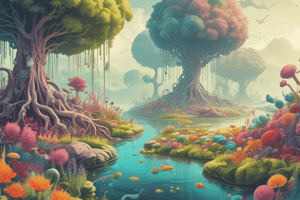Podcast
Questions and Answers
Which type of microorganism lacks a membrane-bound nucleus?
Which type of microorganism lacks a membrane-bound nucleus?
- Fungi
- Archaea
- Protists
- Bacteria (correct)
Where can Archaea be found primarily?
Where can Archaea be found primarily?
- Hot springs (correct)
- Soil
- Water
- Mushrooms
Which group of microorganisms includes yeasts, molds, and mushrooms?
Which group of microorganisms includes yeasts, molds, and mushrooms?
- Fungi (correct)
- Protists
- Bacteria
- Archaea
What role do bacteria play in the environment?
What role do bacteria play in the environment?
Which type of microorganism is NOT eukaryotic?
Which type of microorganism is NOT eukaryotic?
What distinguishes protists from other types of microorganisms?
What distinguishes protists from other types of microorganisms?
What is the crucial role of protists in the environment?
What is the crucial role of protists in the environment?
Which component of viruses is responsible for their genetic material?
Which component of viruses is responsible for their genetic material?
What is a common example of a symbiotic relationship involving microorganisms and plants?
What is a common example of a symbiotic relationship involving microorganisms and plants?
How do probiotics, such as Lactobacillus and Bifidobacteria, impact human health?
How do probiotics, such as Lactobacillus and Bifidobacteria, impact human health?
What do viruses rely on for replication?
What do viruses rely on for replication?
How do microorganisms impact the transfer of genetic material between organisms?
How do microorganisms impact the transfer of genetic material between organisms?
Study Notes
Exploring the Diverse World of Microorganisms in the Environment
Microorganisms are tiny living beings that inhabit our planet in enormous numbers, playing crucial roles in maintaining the delicate balance of ecosystems. In this article, we'll delve into the various types of these microscopic organisms that are found throughout the environment.
Bacteria
Bacteria are the most abundant and widely distributed microorganisms. They are single-celled, prokaryotic organisms that lack a membrane-bound nucleus. Bacteria can live in diverse environments, including soil, water, and even deep within rock formations. They contribute to essential processes such as decomposition, nitrogen fixation, and the breakdown of complex organic compounds.
Archaea
Archaea are another group of prokaryotic microorganisms that can be found in extreme environments, such as hot springs, deep-sea hydrothermal vents, and high-salt environments. Archaea are incredibly diverse, and many species have unique metabolic capabilities.
Fungi
Fungi are eukaryotic microorganisms that include yeasts, molds, and mushrooms. They play essential roles in the environment, including decomposing organic matter, symbiotic relationships with plants, and serving as a food source for other organisms.
Protists
Protists are eukaryotic microorganisms that do not fit into other established categories. They include single-celled organisms such as algae, amoebas, and protozoa. Protists are diverse, with some species being photosynthetic, heterotrophic, or even parasitic. They play crucial roles in the environment, such as primary production, decomposition, and nutrient cycling.
Viruses
Viruses are not considered living organisms, but they are crucial components of microbial communities. Viruses have a protein coat called a capsid and a genetic material core. They rely on host cells for replication and can infect bacteria, archaea, fungi, plants, and animals. Viruses are essential components of ecosystems, as they regulate microbial populations and influence the transfer of genetic material between organisms.
Symbiotic Relationships
Many microorganisms form symbiotic relationships with other organisms, such as plants and animals. For example, mycorrhizal fungi form symbiotic relationships with plant roots, allowing plants to access nutrients and water more efficiently. In return, the plants provide the fungi with carbohydrates.
Microorganisms and Human Health
Microorganisms can have positive and negative impacts on human health. Some microorganisms, such as probiotics (e.g., Lactobacillus and Bifidobacteria), are beneficial for human health and help maintain gut health. Other microorganisms, such as pathogens (e.g., bacteria, viruses, and parasites), can cause diseases. Understanding the diverse roles of microorganisms in the environment helps us better understand their impacts on human health and develop strategies to improve public health.
In conclusion, microorganisms are incredibly diverse and play essential roles in maintaining the delicate balance of ecosystems. Understanding the various types of microorganisms and their roles in the environment is crucial for developing strategies to improve public health, preserve environmental quality, and mitigate climate change.
Studying That Suits You
Use AI to generate personalized quizzes and flashcards to suit your learning preferences.
Description
Test your knowledge on the diverse world of microorganisms and their roles in the environment. From bacteria to viruses and symbiotic relationships, this quiz covers various types and functions of microorganisms.




